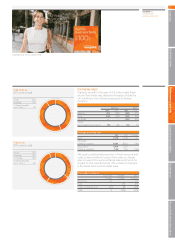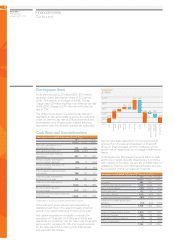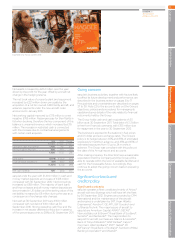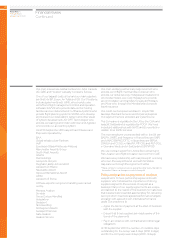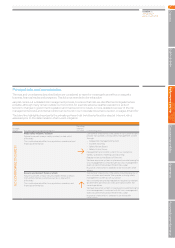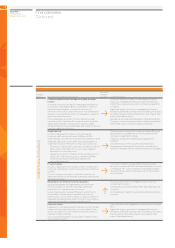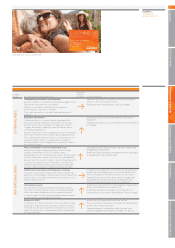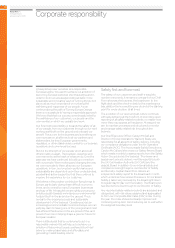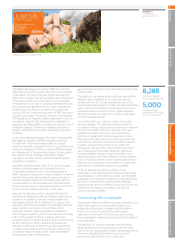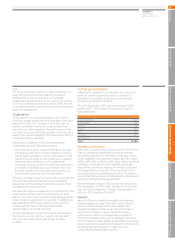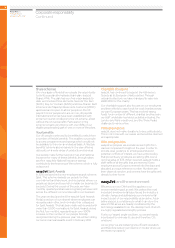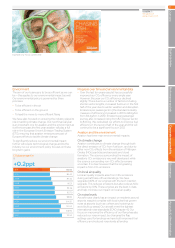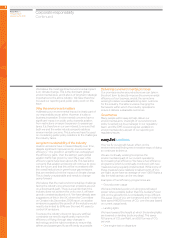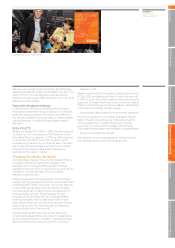EasyJet 2011 Annual Report Download - page 32
Download and view the complete annual report
Please find page 32 of the 2011 EasyJet annual report below. You can navigate through the pages in the report by either clicking on the pages listed below, or by using the keyword search tool below to find specific information within the annual report.
30
Financial review
Continued
easyJet plc
Annual report
and accounts 2011
Strategic
impact Risk description and potential impact
Prevailing
inherent
risktrend Current mitigation
END TO END CUSTOMER PROPOSITION
Missing optimisation opportunities for aircraft fleet and
network portfolio
easyJet has a leading presence on the top 100 routes in
Europe and positions at primary airports that are attractive
to time sensitive consumers. easyJet manages the
performance of its network by careful allocation of aircraft
to routes and optimisation of its flying schedule.
If we fail to continue to optimise our network and fleet plan
this will have a major impact on easyJet’s ability to grow and
gain the required yield. In addition, poor planning of the
correct number of aircraft to fly the schedule would have a
critical impact on the Company’s costs and reputation.
s
A Network Portfolio Management Strategy is in place which
looks to take a balanced approach to the route portfolio that
we fly to ensure that we optimise each aircraft to get the
best return for each time of day, each day of the week.
Route performance is monitored on a regular basis and
operating decisions are made to improve performances
where required.
Exposure to fuel price fluctuations and other
macroeconomic shifts
Sudden and significant increases in jet fuel price and
movements in foreign exchange rates would significantly
impact fuel and other costs. Increases in fuel costs have a
direct impact on the financial performance of the Company.
If not mitigated, this could have a material adverse effect on
financial performance.
easyJet’s business can also be affected by macroeconomic
issues outside of its control such as weakening consumer
confidence, inflationary pressure or instability of the euro.
This could give rise to adverse pressure on revenue, load
factors and residual values of aircraft.
i
Board approved hedging (jet fuel and currency) in place that
is consistently applied. Policy is to hedge within a percentage
band for rolling 24 month periods.
To provide protection, the Group uses a limited range of
hedging instruments traded in the over the counter (OTC)
markets, principally forward purchases, with a number of
approved counterparties.
A strong balance sheet supports business through
fluctuations in the economic conditions for the sector.
Regular monitoring of markets and route performance by
our network and fleet management teams.
FINANCIAL DISCIPLINE
Financing and interest rate risk
All of the Group’s debt is asset related, reflecting the capital
intensive nature of the airline industry.
Market conditions could change the cost of finance which
may have an adverse effect on the financial performance. p
Group interest rate management policy aims to provide
certainty in a proportion of its financing.
Operating lease rentals are a mix of fixed and floating rates
(currently 68% to 32%).
All on balance sheet debt floating rate, repriced up to
sixmonths.
None of the agreements contain financial covenants.
A portion of US dollar mortgage debt is matched with
USdollar money market deposits.
Liquidity risk
The Group continues to hold significant cash or liquid funds
as a form of insurance.
Lack of sufficient liquid funds could result in business
disruption and have a material adverse effect on financial
performance.
p
Board policy is to maintain an absolute minimum level of free
cash and money market deposits.
Allows business to ride out downturns in business or
temporary curtailment of activities (e.g. fleet grounding,
security incident, extended industrial dispute at key supplier).
Credit risk
Surplus funds are invested in high quality short-term liquid
instruments, usually money market funds or bank deposits.
Possibility of material loss arising in the event of non-
performance of counterparties.
i
Cash is placed on deposit with institutions based upon credit
rating with a maximum exposure of £100 million for AAA
ratings.
Chris Kennedy
Chief Financial Officer
Example only. Not a current offer.



